INSTITUT SUPERIEUR D'ANTHROPOLOGIE
INSTITUTE OF ANTHROPOLOGY
ONLINE COURSES / COURS A DISTANCE
WINTER TERM : JANUARY 2014
REGISTER NOW
EGYPTE – 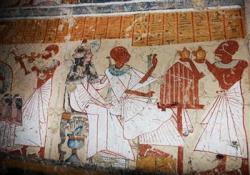 Louxor - Egypt's minister of antiquities says Japanese archeologists have unearthed the tomb of an ancient beer brewer in the city of Luxor that is more than 3,000 years old. Mohammed Ibrahim says Friday the tomb dates back to the Ramesside period and belongs to the chief "maker of beer for gods of the dead" who was also the head of a warehouse. He added that the walls of the tomb's chambers contain "fabulous designs and colors, reflecting details of daily life ... along with their religious rituals." The head of the Japanese team, Jiro Kondo, says the tomb was discovered during work near another tomb belonging to a statesmen under Amenhotep III, grandfather of the famed boy-pharaoh.
Louxor - Egypt's minister of antiquities says Japanese archeologists have unearthed the tomb of an ancient beer brewer in the city of Luxor that is more than 3,000 years old. Mohammed Ibrahim says Friday the tomb dates back to the Ramesside period and belongs to the chief "maker of beer for gods of the dead" who was also the head of a warehouse. He added that the walls of the tomb's chambers contain "fabulous designs and colors, reflecting details of daily life ... along with their religious rituals." The head of the Japanese team, Jiro Kondo, says the tomb was discovered during work near another tomb belonging to a statesmen under Amenhotep III, grandfather of the famed boy-pharaoh.
http://www.hurriyetdailynews.com/tomb-of-ancient-egyptian-beer-brewer-unearthed.aspx?pageID=238&nID=60630&NewsCatID=375
MEXIQUE – 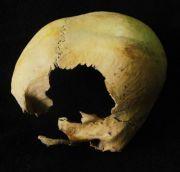 Mexico - Four skulls that formed part of an altar made of human bones from the Late Post-Classical period (1350-1521) were found during the construction of a new Mexico City metro line, authorities said. The skulls are from two men, one woman and a dog, Mexico’s National Anthropology and History Institute, or INAH, said in a communique. The two men were estimated to be between 25-35 years of age and less than 35, respectively, at the time of their deaths, and the woman was estimated to be between 18-22 years old, the latter skull having been intentionally deformed, INAH said.Much evidence of pre-Columbian settlement in the region has been detected during various construction work, and the archaeological items uncovered to date includes houses, stone- and slab-lined canals, sculptures, much ceramic material and about 100 graves, most of them of infants. The skulls each show perforations of the temples, which indicates that they were probably placed on a rod or stick to be displayed on a “tzompantli,” or skull rack, where the skulls of sacrificial victims were commonly mounted. However, ultimately they were removed from there and were not part of a rack when unearthed, INAH said. With regard to the dog skull, INAH said that it might be that dogs were connected with funerary rites, perhaps to accompany the souls of the dead to the underworld, but this is the first time that such a dog skull has been found with perforations showing that it was, at one time, displayed on a skull rack.
Mexico - Four skulls that formed part of an altar made of human bones from the Late Post-Classical period (1350-1521) were found during the construction of a new Mexico City metro line, authorities said. The skulls are from two men, one woman and a dog, Mexico’s National Anthropology and History Institute, or INAH, said in a communique. The two men were estimated to be between 25-35 years of age and less than 35, respectively, at the time of their deaths, and the woman was estimated to be between 18-22 years old, the latter skull having been intentionally deformed, INAH said.Much evidence of pre-Columbian settlement in the region has been detected during various construction work, and the archaeological items uncovered to date includes houses, stone- and slab-lined canals, sculptures, much ceramic material and about 100 graves, most of them of infants. The skulls each show perforations of the temples, which indicates that they were probably placed on a rod or stick to be displayed on a “tzompantli,” or skull rack, where the skulls of sacrificial victims were commonly mounted. However, ultimately they were removed from there and were not part of a rack when unearthed, INAH said. With regard to the dog skull, INAH said that it might be that dogs were connected with funerary rites, perhaps to accompany the souls of the dead to the underworld, but this is the first time that such a dog skull has been found with perforations showing that it was, at one time, displayed on a skull rack.
http://www.hispanicallyspeakingnews.com/latino-daily-news/details/pre-columbian-skulls-found-while-expanding-metro-line-in-mexico/28583/
INDE – 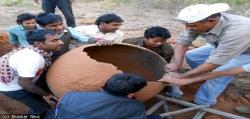
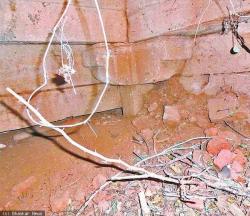 Chandravati - The archaeologists in the city of Chandravati city near Udaipur were taken in for a pleasant surprise after they unearthed a pot and bricks belonging to the ancient times. Initially they could not even budge the pot from its place but with the help of around five to seven men, this pot was pulled out from beneath the soil. Soil was carefully removed from the surface of the pot after it was dug out. Excavations revealed that the pot was kept in a secure manner with very strong arrangements. Ancient bricks used to build houses in earlier times were also unearthed. Archaeologists disclosed that in those days houses were made of bricks whereas temples were made of huge slabs of stone.On Sunday morning, excavations were carried out at Mound No. 1 under the guidance of some archaeologists. The excavation that was carried out under the leadership of Professor Jeevan Lal Kharagwal of Rajasthan Vidhyapeeth unearthed a post that was five feet long and 2.5 feet wide that was buried deep in the soil. The huge pot was rested on a wooden ladder and taken out of the soil with the help of ropes. The excavation work that was started on Saturday revealed a room, a big pot and tunnels dug at various places. The archaeologists are still unaware of where the tunnels lead to. The pot recovered from beneath the soil was so big that a person can be fitted in it.
Chandravati - The archaeologists in the city of Chandravati city near Udaipur were taken in for a pleasant surprise after they unearthed a pot and bricks belonging to the ancient times. Initially they could not even budge the pot from its place but with the help of around five to seven men, this pot was pulled out from beneath the soil. Soil was carefully removed from the surface of the pot after it was dug out. Excavations revealed that the pot was kept in a secure manner with very strong arrangements. Ancient bricks used to build houses in earlier times were also unearthed. Archaeologists disclosed that in those days houses were made of bricks whereas temples were made of huge slabs of stone.On Sunday morning, excavations were carried out at Mound No. 1 under the guidance of some archaeologists. The excavation that was carried out under the leadership of Professor Jeevan Lal Kharagwal of Rajasthan Vidhyapeeth unearthed a post that was five feet long and 2.5 feet wide that was buried deep in the soil. The huge pot was rested on a wooden ladder and taken out of the soil with the help of ropes. The excavation work that was started on Saturday revealed a room, a big pot and tunnels dug at various places. The archaeologists are still unaware of where the tunnels lead to. The pot recovered from beneath the soil was so big that a person can be fitted in it.
http://daily.bhaskar.com/article-hf/RAJ-JPR-archaeological-gain-huge-clay-pot-dug-out-from-the-ruins-of-chandravati-4485742-PHO.html?seq=1
EGYPTE – 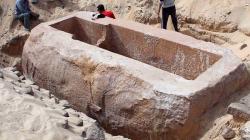
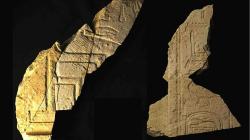 Abydos - A US team in Egypt has identified the tomb of pharaoh Sobekhotep I, believed to be the founder of the 13th dynasty 3,800 years ago, the antiquities minister said on Monday. The team from the University of Pennsylvania had discovered the quartzite sarcophagus of Sobekhotep I, which weighed about 60 tonnes, a year ago, but was unable to identify who it belonged to until last week, the ministry said. Its identity was established after the team found fragments of a slab inscribed with the pharaoh's name and showed him sitting on a throne, Antiquities Minister Mohamed Ibrahim said in a statement. "He is likely the first who ruled Egypt at the start of the 13th dynasty during the second intermediate period," the minister said. The discovery is important as not much information was available about Sobekhotep I "who ruled Egypt for four years and a half, the longest rule at this time," said Ayman El-Damarani, a ministry official. The tomb's discovery in the southern archaeological site of Abydos is expected to reveal more details about his life and rule, he added. The team also discovered the remnants of canopic vases traditionally used to preserve internal body organs, along with gold objects owned by the king.
Abydos - A US team in Egypt has identified the tomb of pharaoh Sobekhotep I, believed to be the founder of the 13th dynasty 3,800 years ago, the antiquities minister said on Monday. The team from the University of Pennsylvania had discovered the quartzite sarcophagus of Sobekhotep I, which weighed about 60 tonnes, a year ago, but was unable to identify who it belonged to until last week, the ministry said. Its identity was established after the team found fragments of a slab inscribed with the pharaoh's name and showed him sitting on a throne, Antiquities Minister Mohamed Ibrahim said in a statement. "He is likely the first who ruled Egypt at the start of the 13th dynasty during the second intermediate period," the minister said. The discovery is important as not much information was available about Sobekhotep I "who ruled Egypt for four years and a half, the longest rule at this time," said Ayman El-Damarani, a ministry official. The tomb's discovery in the southern archaeological site of Abydos is expected to reveal more details about his life and rule, he added. The team also discovered the remnants of canopic vases traditionally used to preserve internal body organs, along with gold objects owned by the king.
http://www.news.com.au/technology/science/american-diggers-identify-tomb-of-egypt-pharaoh-sobekhotep-i/story-fnjwl1aw-1226796203554